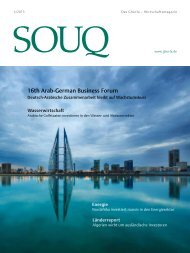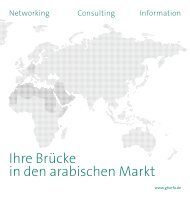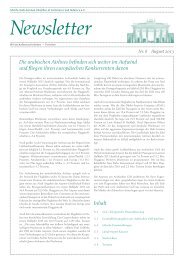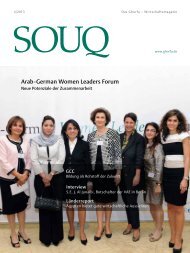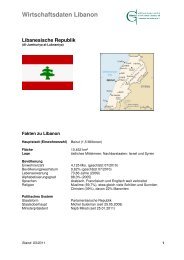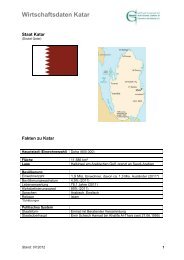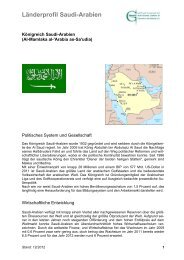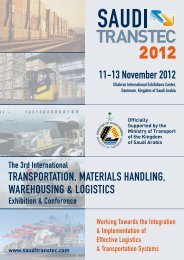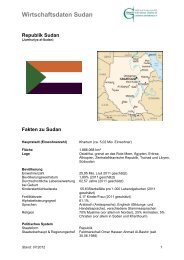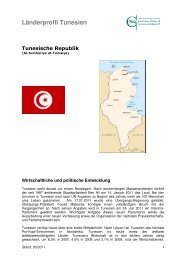Saudi-Arabien Wirtschaftshandbuch Saudi Arabia Business ... - Ghorfa
Saudi-Arabien Wirtschaftshandbuch Saudi Arabia Business ... - Ghorfa
Saudi-Arabien Wirtschaftshandbuch Saudi Arabia Business ... - Ghorfa
Erfolgreiche ePaper selbst erstellen
Machen Sie aus Ihren PDF Publikationen ein blätterbares Flipbook mit unserer einzigartigen Google optimierten e-Paper Software.
Mit einem Investitionsaufwand von 6,7 Mrd. US$ plant<br />
SAGIA die Errichtung der knowledge economic city in<br />
Medina. Diese Stadt soll sich als ein Forschungs- und<br />
Wissenschaftszentrum und einer adäquaten sozialen Infrastruktur<br />
mit 20.000 neuen Arbeitsplätzen etablieren.<br />
Etwa 725 Kilometer südlich von Jeddah ist am Roten<br />
Meer die Jazan economic city geplant. Dieses Wirtschaftszentrum<br />
soll neben einem Seehafen, einer Industriezone<br />
und einem Geschäftszentrum auch verschiedene<br />
Bildungseinrichtungen beherbergen. Als<br />
Hauptproduktionsstätten sind in der Industriezone eine<br />
Ölraffinerie, ein petrochemischer Komplex, ein Stahlwerk,<br />
eine Kupferschmelze und ein Aluminiumkomplex<br />
geplant. Die Stadt soll auch über eine eigene Kraftwerks-<br />
und Entsalzungsanlage verfügen.<br />
Ferner soll im Norden Hails die nach dem ersten Gouverneur<br />
dieser Provinz genannte Wirtschaftsstadt<br />
Prince Abdulaziz bin Musaid economic city entstehen.<br />
Durch diese Wirtschaftsstadt soll sich Hail zu einem<br />
Logistikzentrum entwickeln. Damit soll in erster Linie<br />
der natürliche Reichtum der Region, die über eine relativ<br />
ausgebaute Landwirtschaft und über reiche Mineralienvorkommen<br />
verfügt, erschlossen werden. Erbaut<br />
werden u. a. ein Flughafen, ein Eisenbahnanschluss,<br />
ein Trockendock sowie Wohn- und Geschäftsviertel.<br />
Ferner legte der König den Grundstein für eine neue<br />
Universität. Investitionen in Höhe von 8 Mrd. US$ sind<br />
geplant. Daneben sollen die Errichtung eines großen<br />
Naturschutzparks, der Bau einer Autorennstrecke sowie<br />
die urzeitlichen Felsmalereien der Förderung des<br />
innerarabischen Tourismus dienen.<br />
Mit der Errichtung dieser neuen Wirtschaftszentren<br />
setzt sich die saudische Regierung das Ziel, ein stabiles<br />
Wirtschaftswachstum verbunden mit der Schaffung<br />
neuer Beschäftigungsmöglichkeiten zu sichern und die<br />
industrielle Diversifizierung voranzutreiben.<br />
Model king Abdullah economic city<br />
enTWicklunG WichTiGer SekTOren unD POTenziAle – – develoPment of ImPortAnt SectorS And exIStInG PotentIAlS<br />
–––––––––––––––––––––––––––––––<br />
centreS of the mAnufActurInG<br />
InduStry And town PlAnnInG<br />
In 1975 a master plan was drawn up for turning around<br />
22,000ha of desert land into the mega industrial towns<br />
of Jubail and yanbuc. The vision of the then King Faisal<br />
was based on the idea that the development of the sea<br />
ports of these industrial locations would create strategic<br />
connections to the shipping routes through the Gulf of<br />
<strong>Arabia</strong> and the Red Sea thus fulfilling a basic precondition<br />
for the long-term integration of <strong>Saudi</strong> <strong>Arabia</strong> into<br />
the world economy. Even today, the industrial towns of<br />
Yanbu and Jubail play a key role in the development of<br />
the mineral oil and natural gas manufacturing industry,<br />
other energy-intensive areas and the manufacturing industry,<br />
for which the state company <strong>Saudi</strong> Basic Industries<br />
Corporation (SABIC) and ARAMCO in particular<br />
were responsible.<br />
Today, more than 100,000 people live in the industrial<br />
town of Jubail. The population is due to grow to approx.<br />
290,000 by the year 2010. The town already has an adequate<br />
water and energy supply system. The infrastructure<br />
also contains a complex network of roads, an airport and<br />
a modern sea port that is equipped for loading tankers<br />
and handling mass goods and containers. More than 20<br />
large companies that produce steel, aluminium, synthetics,<br />
industrial gases and fertilisers have already located<br />
into the Jubail industrial park. Also, there are over 150<br />
production facilities from a number of supply industries.<br />
The town planners were careful to separate the industrial<br />
locations from the residential areas. These residential areas<br />
have all the facilities of a modern social infrastructure.<br />
Today, almost 100,000 people live in the industrial town<br />
of yanbuc. The population is due to grow to approx.<br />
150,000 by the year 2010. Yanbu already has an adequate<br />
water and energy supply system. The town planners developed<br />
the town as a model for modernising other towns<br />
in the north-west coastal region. The port in Yanbu is the<br />
largest on the Red Sea and is also fully equipped with all<br />
modern handling equipment required for loading super<br />
tankers. Important production facilities in Yanbu include<br />
refineries, plants for producing liquid gas and an aluminium<br />
melting plant owned by one of the largest companies,<br />
namely Al-Lajeen.<br />
Both Jubail and Yanbuc play an important role in the<br />
<strong>Saudi</strong> economy today as around half of the industrial<br />
production of the country is produced in these two towns.<br />
51



